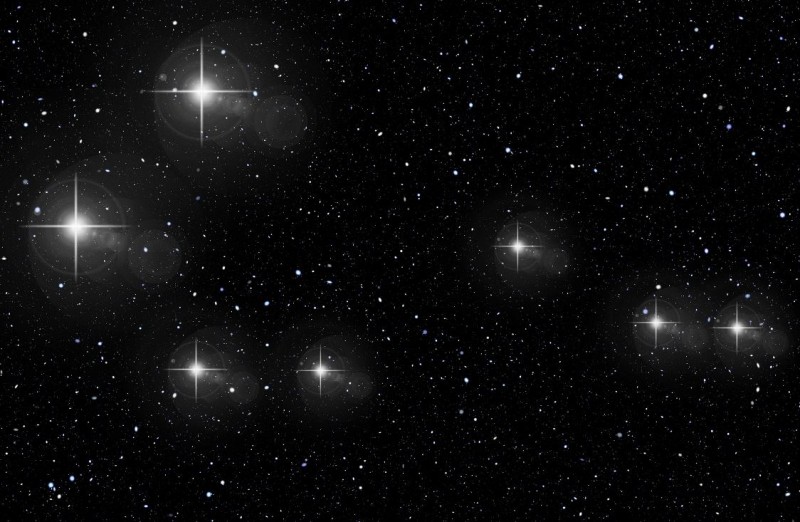
Introduction
When we gaze up at the night sky, we often recognize familiar constellations such as Orion, Ursa Major, and Cassiopeia. However, the night sky is adorned with a myriad of lesser-known constellations, each with its own fascinating history and mythology. In this article, we will explore the captivating tales behind these constellations and discover their significance in ancient cultures and modern times.
What Are Constellations?
Constellations are patterns formed by groups of stars in the night sky. They have been used by humans for thousands of years to navigate, tell stories, and connect with the celestial realm. Some constellations are well-known and easily identifiable, while others are lesser-known and often overlooked.
The Role of Constellations in Ancient Civilizations
Ancient civilizations across the globe have attached great significance to constellations. They observed and studied the stars, attributing them with mythical tales and using them for practical purposes. Constellations served as celestial markers, helping navigators traverse the seas, guide travelers across deserts, and determine the changing of seasons for agricultural activities.
Famous Constellations and Their Legends
Before we delve into the lesser-known constellations, let's briefly explore some famous ones and the legends associated with them.
4.1 Orion
Orion, the mighty hunter, is one of the most recognizable constellations in the night sky. According to Greek mythology, Orion was a skilled hunter who challenged the gods. He was eventually defeated and placed among the stars, forever immortalized.
4.2 Ursa Major and Ursa Minor
Ursa Major and Ursa Minor, also known as the Big Dipper and the Little Dipper, respectively, are prominent constellations in the northern hemisphere. In Greek mythology, these constellations represent Callisto and her son Arcas, who were transformed into bears by the jealous goddess Hera.
4.3 Draco
Draco, the dragon constellation, winds its way between Ursa Major and Ursa Minor. In Greek mythology, Draco represents Ladon, the dragon who guarded the golden apples in the Garden of the Hesperides.
4.4 Cassiopeia
Cassiopeia, a constellation resembling a "W" or "M" shape, is named after the queen of Ethiopia in Greek mythology. She was known for her beauty and vanity and was placed among the stars as punishment for her arrogance.
Lesser-Known Constellations
While the famous constellations capture our attention, there are many lesser-known constellations that possess their own allure. Let's explore a few of them:
5.1 Equuleus
Equuleus, the Little Horse, is a small constellation located in the northern hemisphere. It represents a young foal and is associated with the myth of Hippocamp, the horse of Poseidon, the Greek god of the sea.
5.2 Lynx
Lynx is a faint constellation located between the constellations Ursa Major and Auriga. It depicts a lynx, a wild cat known for its elusive nature. Lynx is not associated with any particular myth, but its presence in the night sky adds to the celestial tapestry.
5.3 Cetus
Cetus, the Sea Monster, is a large constellation situated in the southern hemisphere. In Greek mythology, Cetus represents the sea monster sent by Poseidon to terrorize the coast of Ethiopia. It was eventually slain by the hero Perseus.
5.4 Corona Borealis
Corona Borealis, also known as the Northern Crown, is a small constellation shaped like a crown. It is associated with the myth of Ariadne, who was abandoned by Theseus on the island of Naxos. The god Dionysus took pity on her and placed her crown in the sky as a symbol of their love.
The Mythology behind Lesser-Known Constellations
Let's delve deeper into the mythology behind these lesser-known constellations:
6.1 Equuleus - The Little Horse
According to Greek mythology, Equuleus represents the young horse Hippocamp, born from the union of Poseidon and Medusa. It is said to symbolize grace, agility, and the powerful connection between humans and horses.
6.2 Lynx - The Elusive Creature
While Lynx doesn't have a specific myth associated with it, its inclusion in the night sky pays homage to the beauty and mystery of the lynx. This constellation reminds us of the wonders of the natural world and the creatures that inhabit it.
6.3 Cetus - The Sea Monster
Cetus, the Sea Monster, represents the creature sent by Poseidon to wreak havoc along the coast of Ethiopia. Its inclusion in the constellations serves as a reminder of the power of the sea and the importance of respecting its forces.
6.4 Corona Borealis - The Northern Crown
Corona Borealis is associated with the story of Ariadne, who helped Theseus defeat the Minotaur in the labyrinth. After being abandoned by Theseus, she found solace in the arms of Dionysus, who immortalized her crown in the night sky as a symbol of their love and her eternal beauty.
The Significance of Lesser-Known Constellations Today
While the lesser-known constellations may not be as widely recognized as their famous counterparts, they still hold cultural and scientific significance. They connect us to the rich history of human fascination with the stars and serve as reminders of ancient myths and stories. Moreover, they inspire curiosity and encourage exploration of the celestial wonders beyond the familiar.
Conclusion
The night sky is a treasure trove of wonders, filled with both renowned and lesser-known constellations. Each constellation, whether famous or not, carries a captivating history and mythology that enriches our understanding of the cosmos and our place within it. Exploring the stories behind these constellations allows us to embark on a celestial journey, connecting us to ancient civilizations and igniting ourimagination. As we gaze up at the stars, let us remember the tales of Equuleus, Lynx, Cetus, and Corona Borealis, among others, and appreciate the vastness of the universe and the beauty it holds.
BREAKING! Manipur violence, Mob sets two vehicles on fire
Rahul Gandhi Demonstrates Solidarity with Farmers by Riding a Tractor in Sonipat
The Rise of Digital Nomads: Balancing Work and Travel in the Digital Age